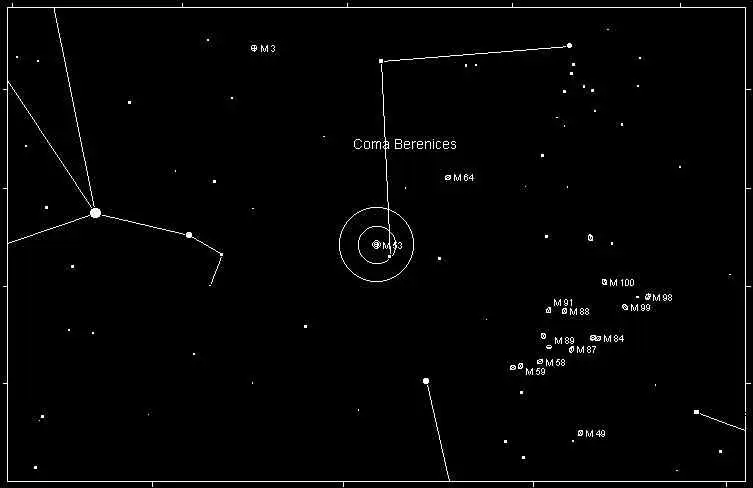Messier 53 (M53), also known as NGC 5024, is one of the most distant globular clusters visible in our galaxy. Discovered by Johann Elert Bode in 1775 and subsequently cataloged by Charles Messier in 1777, M53 is a fascinating object for amateur astronomers and professionals alike. Located in the constellation Coma Berenices, it is a dense collection of stars bound together by gravity, appearing as a faint, smudged ball of light when observed through a telescope.
Description
Messier 53 is a globular cluster, a spherical collection of stars that orbit the galactic core as a satellite. M53 is relatively rich in stars, with over a hundred thousand stars packed into a space of about 220 light-years in diameter. The cluster is about 58,000 light-years away from Earth and 60,000 light-years from the Galactic Center. It is slightly elliptical in shape, with a concentrated core and a gradually diminishing brightness as you move outwards.
The cluster's apparent magnitude is 7.6, which makes it one of the brighter globular clusters but still just beyond the naked-eye visibility range. However, it can be seen with binoculars or a small telescope under good viewing conditions.
Magnitude and Visibility
With an apparent magnitude of 7.6, Messier 53 is not visible to the naked eye, but it is an easy target for small telescopes or binoculars, especially in dark skies. Its integrated magnitude makes it bright enough to stand out in its constellation, Coma Berenices, yet faint enough that a bit of practice might be needed to locate it. The cluster's visibility improves significantly in areas with low light pollution, where its stellar density and structure become more apparent.

Season of Prominence
Messier 53 is best observed during the spring months, particularly from March to May. During this time, the constellation Coma Berenices is well-placed in the night sky, high above the horizon for observers in the Northern Hemisphere. Spring nights are ideal for spotting M53, as it is located near the zenith during this season, reducing the amount of atmospheric distortion and improving visibility.
Constellation
Messier 53 is located in the constellation Coma Berenices, a faint but historically significant constellation named after the hair of Queen Berenice II of Egypt. The constellation lies between the constellations Leo and Boötes, near the northern celestial pole. Although Coma Berenices doesn't contain many bright stars, it is home to several other deep-sky objects, including the Coma Cluster and the famous Black Eye Galaxy (Messier 64).
How to Find Messier 53
To locate Messier 53, start by finding the bright star Arcturus in the constellation Boötes. Arcturus is one of the brightest stars in the night sky and serves as an excellent reference point. From Arcturus, move about 20 degrees to the west to locate the constellation Coma Berenices.
Within Coma Berenices, the star Diadem (Alpha Comae Berenices) is the brightest star, although still faint compared to Arcturus. From Diadem, M53 is located roughly 1 degree to the northeast. When scanning this area with binoculars or a telescope, you should see a faint, misty patch of light—this is Messier 53.
Using a telescope with an aperture of at least 4 inches, you can begin to resolve individual stars within the cluster. The core will appear more concentrated, with stars becoming more diffuse as you move outward.

History
Messier 53 was first discovered by the German astronomer Johann Elert Bode in 1775. Charles Messier independently discovered it and added it to his catalog of comet-like objects on February 26, 1777. Interestingly, M53 was one of the first globular clusters where astronomers detected the presence of variable stars, which change in brightness over time. These discoveries have helped scientists learn more about the structure and evolution of globular clusters.
Over the years, M53 has been studied extensively, providing valuable insights into the formation and evolution of stars in globular clusters. The cluster has a population of stars primarily composed of older, metal-poor stars, which is typical for globular clusters. This metal deficiency suggests that M53, like many other globular clusters, formed early in the history of the Milky Way.
Conclusion
Messier 53 is a captivating globular cluster that offers a rewarding experience for amateur astronomers. Its rich history, coupled with its visibility in the spring sky, makes it a popular target for stargazers. Whether you're using binoculars or a more powerful telescope, M53 provides a glimpse into the ancient past of our galaxy, offering a spectacular view of a densely packed stellar environment.
